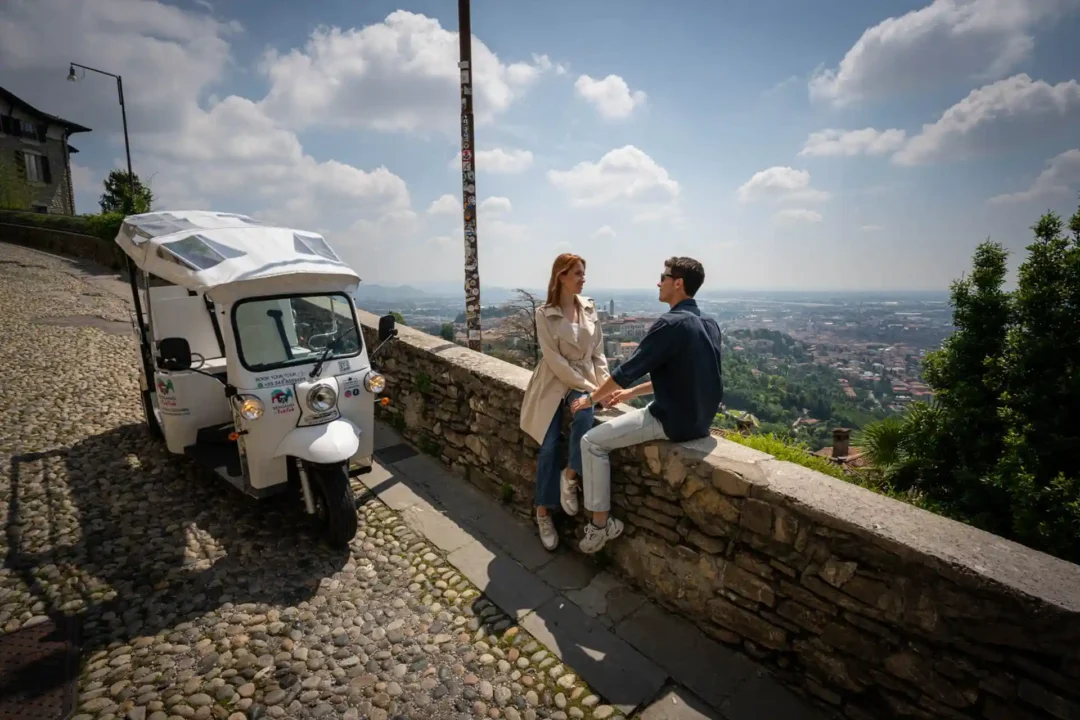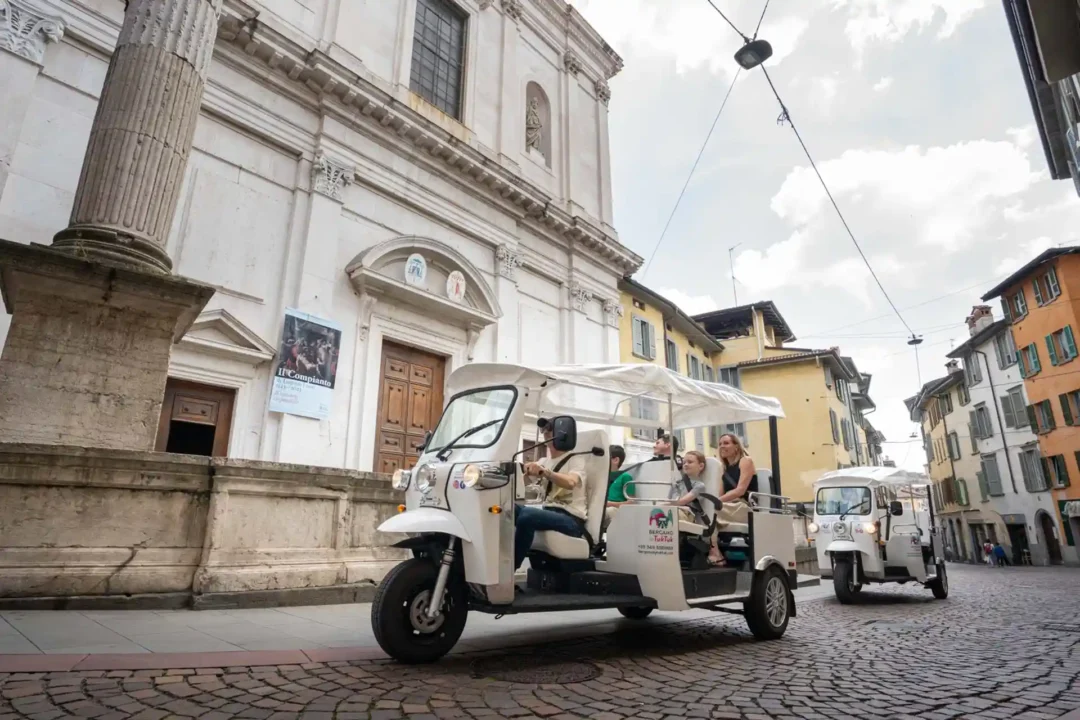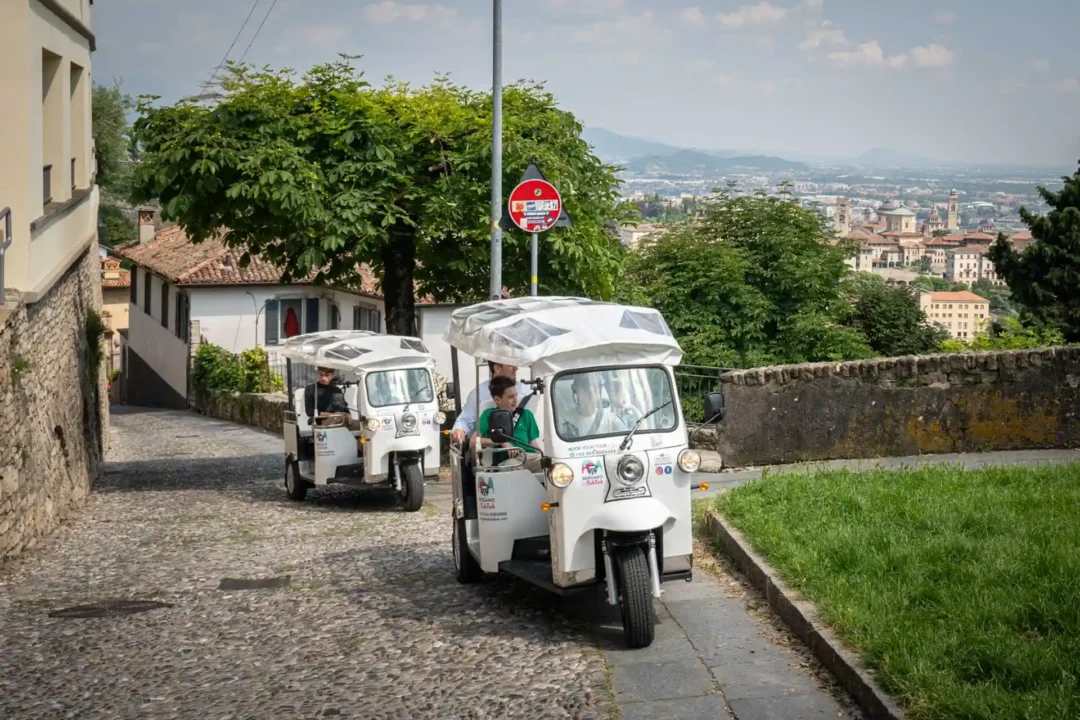

03 April 2025
Bergamo’s Historic Houses represent a precious architectural heritage that tells us centuries of history, art and culture. Among noble palaces, historic villas and fortified residences, these structures offer a fascinating journey into the past, bearing witness to the elegance and prestige of the city.
Before delving into the most important historic houses in the City of the Thousand, let’s review together what Historic House means, and the steps to obtain this kind of recognition.
What is a Historic House?
Historic Houses are buildings of particular historical and artistic value such as palaces, villas, castles and noble residences that bear witness to Italy’s cultural and architectural evolution. Often privately owned, these structures are protected by Italian legislation as part of the national heritage.
Some of the most famous examples in Italy include:
- Palazzo Colonna in Rome,
- Palazzo Rucellai in Florence,
- Villa La Rotonda in Vicenza.
The Associazione Dimore Storiche Italiane (ADSI) – Association of Italian Historic Houses – founded in 1977, brings together the owners of these properties in order to enhance and preserve them.

Requirements to obtain the Historic House recognition
To obtain recognition as a Historic House in Italy, according to the Code of Cultural Heritage (Legislative Decree 42/2004), the building must demonstrate significant artistic, historical or cultural interest.
The process involves:
- a verification of cultural interest (automatic for buildings with more than 70 years of public ownership),
- an official statement issued by the Superintendence of Cultural Heritage,
- registration in the official registers.
Owners must commit to preserving the original features of the building, submitting any intervention to the Superintendence for approval.
In return, they can benefit from tax concessions, while accepting restrictions on conservation and sometimes on public accessibility.
Historic Houses in Bergamo and around
Palazzo Terzi (Upper Town)
A masterpiece of the Bergamo Baroque architecture, Palazzo Terzi is located in the heart of Città Alta, in a panoramic position overlooking Piazzetta Terzi. The building, which incorporates earlier properties, began construction in the 17th century and is impressive for the magnificence of its interiors, with frescoed halls decorated by artists such as Cristoforo Storer and Domenico Ghislandi. Particularly impressive are the Ballroom, with its original terracotta floor, the Red Room, the Mirror parlours and the so-called Soprarizzo parlour, with inlaid wooden floors. This palace also houses a collection of paintings, porcelain and period furniture that testify to the refined taste of the Bergamo nobility.

Palazzo Terzi
Palazzo Agliardi (via Pignolo)
Located in the historic centre of Bergamo, Palazzo Agliardi is a magnificent 18th-century noble residence. The façade, characterised by an elegant stone portal and wrought-iron balconies, conceals extraordinarily beautiful interiors and a refined garden. Of particular value are the central hall and the rooms with 18th-century frescoes by Carlo Carloni and Federico Ferrario. The palace also houses a rich collection of period furniture, paintings and art objects that belonged to the Agliardi family, protagonists of Bergamo’s political and cultural life.
Villa Grismondi Finardi (Redona District)
Located in the Redona district, this splendid 18th-century villa is surrounded by a magnificent and ancient park. This neoclassical building is famous for having been visited by illustrious personalities such as Ugo Foscolo, who met here the Countess Paolina Secco Suardo Grismondi, a poetess and animator of an important literary salon. The interior preserves original decorations, stucco and 18th-century frescoes. The park, with its paths, fountains and rare species, is a significant example of English garden in the Bergamo area.
If you feel like exploring the streets of Bergamo and maybe taking a look at the historic residences we’ve mentioned, you’re in the right place! Contact us and book a Tuk Tuk Tour to discover the “City of the Thousand” in a unique and eco-friendly way. It will be a pleasant and relaxing experience, allowing you to dive into history!
But now, let’s go with our Virtual Tour, leaving the city behind as we continue our journey…
Villa Pagnoncelli Folcieri (Scanzorosciate BG)
Located in Scanzorosciate, Villa Pagnoncelli Folcieri is an elegant example of 18th-century aristocratic architecture with a medieval corner tower. The villa is built around a central courtyard and features a façade characterised by a monumental portal and windows framed by stone decorations. The interiors feature frescoed salons and a valuable collection of period furniture. This complex is set in an ancient park with monumental trees and includes rustic cottages and agricultural outbuildings, evidence of the estate’s ancient wine-growing tradition. The wine cellar inside the villa can be visited as well.

Villa Pagnoncelli Folcieri – Picture taken from www.moscatopagnoncelli.com
Villa dei Tasso (Celadina District)
Located in Celadina, the Villa dei Tasso is linked to the famous family that created the European postal service. Built in the 16th century as a summer residence, the villa has an elegant façade on which the Tasso coat of arms stands out. The large inner courtyard is overlooked by the ancient stables and the tall dovecote tower. The rooms are decorated with beautiful frescoes depicting bucolic subjects as well as portraits of distinguished members of the family. There is also a small private oratory dedicated to the Madonna Del Rosario.
Villa Pesenti Agliardi (Sombreno BG)
Located in Sombreno, a hamlet of Paladina, this villa is a remarkable example of neoclassical architecture. Designed by the architect Leopoldo Pollack, a student of Piermarini, at the end of the 18th century, the villa is developed on three levels, with a façade characterised by an elegant portico with Doric columns. The interior preserves original decorations, period furniture and a valuable collection of paintings. Of particular interest is the aristocratic chapel and the dining room with its trompe-l’œil painted walls. The surrounding park, with its ancient trees and a small artificial lake, completes the beauty of the complex.
Villa La Gargana (via Rovelli, Bergamo)
Located in an urban suburb that today is hard to imagine as pleasant countryside, Villa La Gargana is of medieval origin and was linked to the extensive land property of the Gargana counts. Today it consists of a multi-storey U-shaped body, which develops around an Italian-style garden, while at the back there is an English-style park. Inside, frescoed halls and original furniture.

Villa La Gargana – Picture taken from www.facebook.com/people/Villa-La-Gargana
Villa Gromo (Mapello BG)
Located in Mapello, Villa Gromo is a splendid 18th-century mansion built on commission of the Zanchi Counts. The building is characterised by its elegant architecture, with a symmetrical façade and a columned portico. The interior features frescoes with allegorical figures, ceilings with aerial perspectives and illusionistic panelled frames, and original Lombard terracotta floors. The complex is surrounded by an English-style park and includes a private chapel decorated with stuccoes and paintings typical of the Lombard school.
Palazzo Barbò (Torre Pallavicina)
Located in Torre Pallavicina, Palazzo Barbò is a magnificent example of the 16th-century Lombard Renaissance architecture. Commissioned by the noble Barbò family, the palace is distinguished by its elegant façade and majestic portico. The interiors are decorated with cycles of frescoes attributed to the Giulio Romano school and finely decorated panelled ceilings. The complex also includes a private chapel and a large Italian-style garden with original fountains.
Palazzo Oldofredi Tadini Botti (Torre Pallavicina)
Chosen as early as the 15th century by the Sforza family as an ideal strategic location for controlling the middle section of the River Oglio, which was on the border with the Venetian Republic, and as a summer residence for hunting and recreation, the palace was enlarged in the 16th century. Of particular interest are the rooms frescoed with the myth of Cupid and Psyche and the elegant loggia. At the end of the 16th century, the Oldofredi family, lords of Calciana, acquired the palace to control customs and duties and the salt trade.
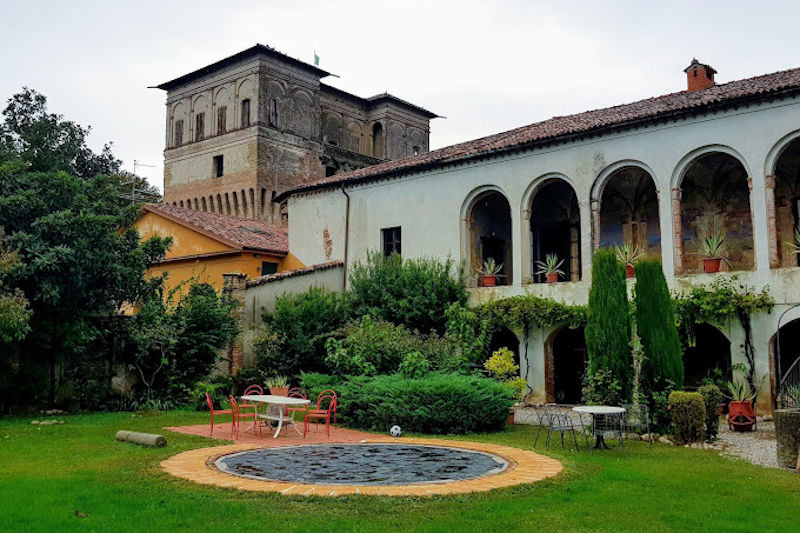
Palazzo Oldofredi Tadini Botti – Picture taken from the Official Google Profile – Photo by Enrico Coma
Villa Redona Medolago Albani (Trescore Balneario)
Located in Trescore Balneario, Villa Redona is an elegant aristocratic residence built in the 18th century in an ancient wine-growing village. The villa is characterised by its access staircase and the large ancient park that surrounds it. The interior features valuable 19th-century frescoes and stucco decorations, as well as a collection of furniture and art objects that belonged to the Medolago Albani family. Of particular interest is the aristocratic chapel dedicated to Santa Caterina and the 18th-century lemon house, perfectly preserved in their original form.
Villa Vitalba Lurani Cernuschi and Convent of San Nicola (Almenno San Salvatore)
Located in Almenno San Salvatore, this monumental complex includes the patrician villa and the ancient convent of San Nicola. The villa, built in the 16th century, has an elegant façade with a loggia and a huge Italian garden. The adjacent 13th-century convent preserves important traces of medieval religious architecture, including a cloister with stone columns and frescoes of sacred subjects. The entire complex is a unique testimony to the fusion of civil and religious architecture in the Bergamo area.
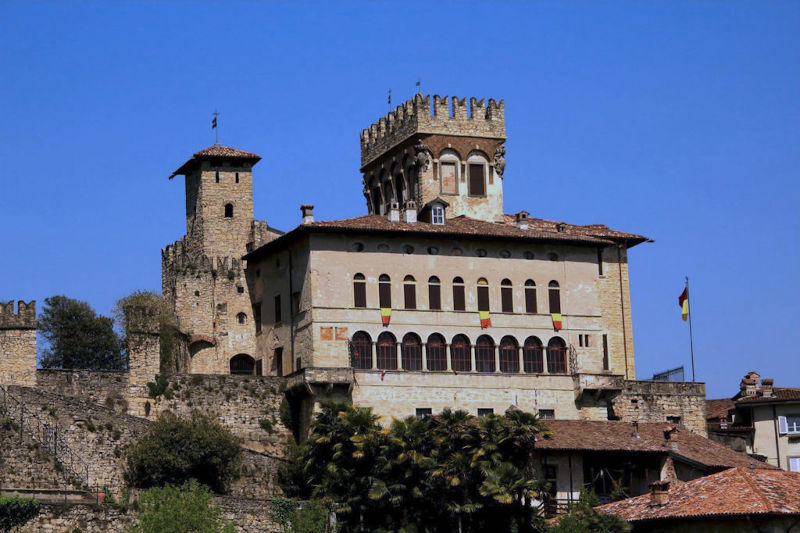
Camozzi Vertova Castle – Picture taken from terredelvescovado.it
Other Historic Houses in Bergamo
The Castles
In addition to the historic houses described above, in the territory of Bergamo and its province we can also find several castles, witnesses to past eras and ancient lordships, which are always to be included in the list of historic houses.
Among them the most important are:
- the Valverde Castle, immersed in the tranquillity of the Bergamo Hills;
- the Cavernago Castle, an elegant Renaissance residence linked to the Colleoni family;
- the Camozzi Vertova Castle, which preserves all the charm of noble residences in Bergamo;
- the Lurano Castle, with its refined architectural structure and its connection to important historical families.
We will explore these fascinating buildings in more detail in a future article.
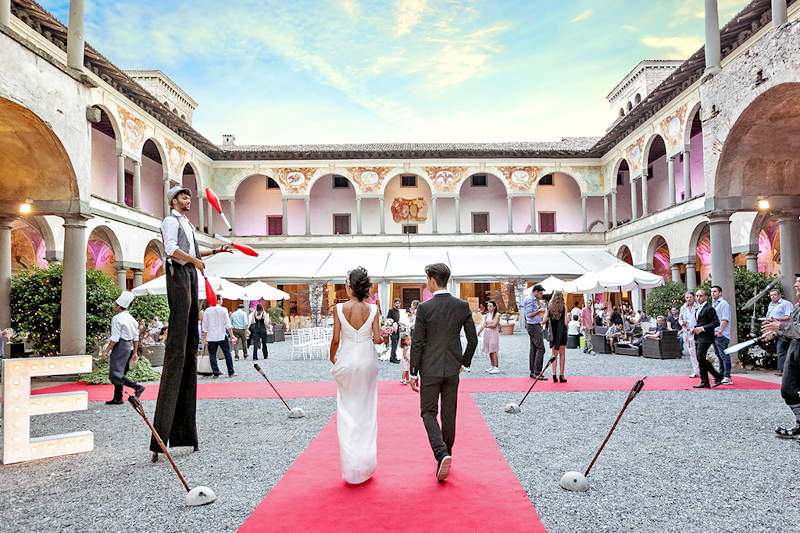
Cavernago Castle – Picture taken from www.castellodicavernago.it
The Historic Houses… that are not Historic Houses
Palazzo Moroni (Upper Town)
Located in the heart of Città Alta, Palazzo Moroni is one of the most elegant examples of 16th-17th century Bergamo Baroque aristocratic architecture. Built by the Moroni family, an important Bergamo household, the palace features precious frescoes by Gian Giacomo Barbelli and a magnificent Italian-style garden arranged on several levels that offers a panoramic view of the city. Inside, the rooms are decorated with period furniture, valuable paintings (including artworks by Moroni, Previtali and Cesare Tallone) and stucco decorations. Particularly impressive is the monumental staircase leading to the piano nobile, the Salone della Gerusalemme Liberata and the series of recently restored 19th-century sitting rooms.
Palazzo Polli Stoppani (Upper Town)
Palazzo Polli Stoppani is one of the most fascinating historical buildings in Bergamo’s Città Alta. Located in Via San Giacomo, this elegant palace, built in the 16th century following a design by Pietro Isabello, was renovated in the 18th century and is built on several floors, leaning against the Rosate hill. The façade, characterised by refined decorative elements and an impressive portal, incorporates the medieval fountain of San Giacomo. Originally owned by the Alborghetti family, the palace was acquired by the Polli Stoppani couple, who commissioned a careful restoration that preserved its historical and artistic value. Today the building hosts cultural events and exhibitions, and it is an important reference point for the city’s artistic life, attracting visitors fascinated by its elegance and rich historical heritage.
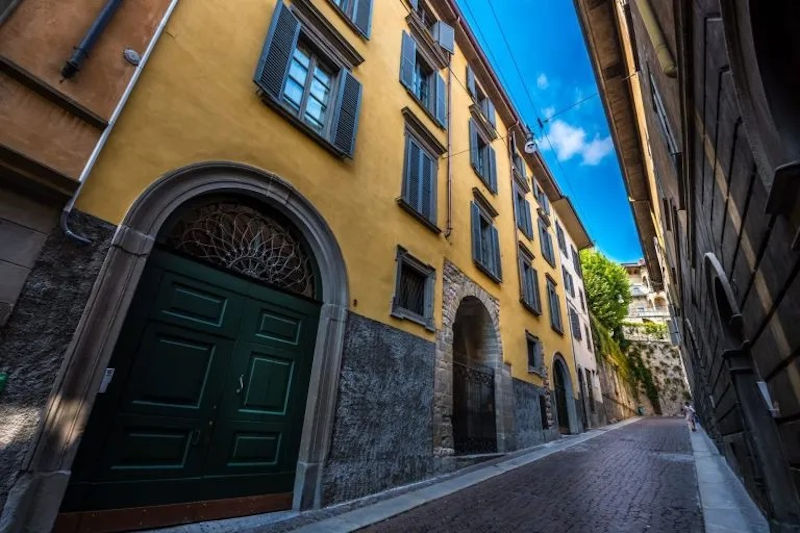
Palazzo Polli Stoppani – Picture taken from www.fondazionepollistoppani.it
Palazzo Medolago Albani
The Palazzo Medolago Albani, an architectural jewel in the heart of Bergamo Alta, is a narration of centuries of the city’s history. Dating back to the 17th century, the building stands out for its elegant Baroque façade, which still catches the eye of visitors strolling along the ancient streets of the city. Owned by important noble families of the area, the palace preserves precious frescoes and furniture inside that testify to the splendour of the Bergamo families of that period.
Historic Houses – Openings
Historic houses in and around Bergamo follow different opening calendars depending on their ownership and management.
It is advisable to always check specific dates and times on the official websites or by contacting the Associazione Dimore Storiche Italiane – Lombardy section, as calendars may vary seasonally.
At the time of publication of this article, we have not found the calendar with the 2025 dates yet, but we leave you with two good references that, once updated, may provide you with the answers you seek.
Historic Houses in Italy – Bergamo (Lombardy)
Guided tours to visit Historic Houses
If you wish to discover the historic houses in and around Bergamo through guided experiences, there are several guided tour options:
The Associazione Dimore Storiche Italiane (ADSI) – Lombardy section periodically organises thematic tours that include several historic houses, with specialised guides and, in some cases, the presence of the owners who will personally welcome visitors. These tours, generally offered in spring and autumn, will also give you the opportunity to access spaces that are not usually open to the public.
As part of its ‘Aperti per Voi’ (Open for You) programme, the Touring Club Italiano offers guided tours of historic houses in Bergamo with cultural guides trained in local history. The tours often include the urban context or landscape in which the residences are set.
The ‘Ville Aperte in Brianza’ initiative, while focusing mainly on the Brianza area, includes some historic houses in the surrounding Bergamo area, offering thematic itineraries, on weekends in September and October.
Several local agencies have developed tourist itineraries dedicated to historic houses, combining visits with food and wine experiences or accommodation in charming structures. Among these, ‘Visit Bergamo’ and ‘Orobie Tourism’ offer customised tours that integrate visits to the residences with other cultural aspects of the area.
For cycling enthusiasts, the ‘Pedalopolis’ association organises bike tours connecting several villas and castles in the Bergamo plain, with scheduled stops and guided tours of the interiors.
During events such as the ‘Giornata Nazionale delle Dimore Storiche’ – National Day of Historic Houses – or the ‘Giornate FAI di Primavera e d’Autunno’ – FAI Spring and Autumn Days -, specific itineraries are proposed, with shuttles that connect the participating houses, allowing visitors to see several of them during the day.

Palazzo Medolago Albani with a Tuk Tuk Tour
Tips for visiting Bergamo’s Historic Houses
For an optimal experience discovering Bergamo’s historic houses, here are some practical tips:
- Plan in advance: Given the limited or pre-booked opening of many houses, it is advisable to organise your visit weeks in advance, either by contacting the structures directly or by consulting the official ADSI Lombardy calendars.
- Thematic itineraries: Organising the visit according to thematic routes can enrich your experience. For example, an itinerary dedicated to Baroque residences could include Palazzo Moroni and Palazzo Terzi, while a route focusing on fortifications could link the Castello di San Vigilio with the Malpaga one.
- Seasons: Spring and early autumn are the ideal times to visit residences with historic gardens and parks, when the blossoms or autumn colours are at their best. Summer, on the other hand, is preferable for venues that organise outdoor events.
- Documentation: Before visiting, it is useful to find out about the history of the owner family and the historical-artistic context of the residence. Many structures offer information material on their websites or at ticket offices.
Searching for Lost Culture with our Tuk Tuks
- Bergamo’s cultural heritage: a journey around its main Museums
- The Accademia Carrara in Bergamo: Art and Culture for over 200 years
- GAMeC, Bergamo’s cultural centre of excellence
- Exhibitions in Bergamo: classical, contemporary and multimedia art
- Bergamo’s Lazaretto: Life beyond Life for 600 years

